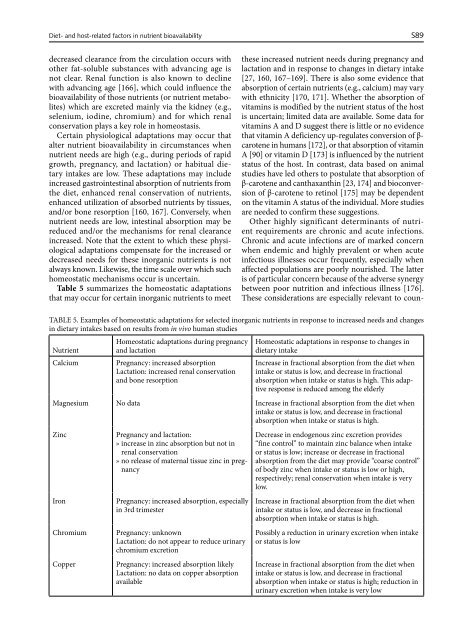Implementing food-based dietary guidelines for - United Nations ...
Implementing food-based dietary guidelines for - United Nations ...
Implementing food-based dietary guidelines for - United Nations ...
Create successful ePaper yourself
Turn your PDF publications into a flip-book with our unique Google optimized e-Paper software.
Diet- and host-related factors in nutrient bioavailability<br />
decreased clearance from the circulation occurs with<br />
other fat-soluble substances with advancing age is<br />
not clear. Renal function is also known to decline<br />
with advancing age [166], which could influence the<br />
bioavailability of those nutrients (or nutrient metabolites)<br />
which are excreted mainly via the kidney (e.g.,<br />
selenium, iodine, chromium) and <strong>for</strong> which renal<br />
conservation plays a key role in homeostasis.<br />
Certain physiological adaptations may occur that<br />
alter nutrient bioavailability in circumstances when<br />
nutrient needs are high (e.g., during periods of rapid<br />
growth, pregnancy, and lactation) or habitual <strong>dietary</strong><br />
intakes are low. These adaptations may include<br />
increased gastrointestinal absorption of nutrients from<br />
the diet, enhanced renal conservation of nutrients,<br />
enhanced utilization of absorbed nutrients by tissues,<br />
and/or bone resorption [160, 167]. Conversely, when<br />
nutrient needs are low, intestinal absorption may be<br />
reduced and/or the mechanisms <strong>for</strong> renal clearance<br />
increased. Note that the extent to which these physiological<br />
adaptations compensate <strong>for</strong> the increased or<br />
decreased needs <strong>for</strong> these inorganic nutrients is not<br />
always known. Likewise, the time scale over which such<br />
homeostatic mechanisms occur is uncertain.<br />
Table 5 summarizes the homeostatic adaptations<br />
that may occur <strong>for</strong> certain inorganic nutrients to meet<br />
S89<br />
these increased nutrient needs during pregnancy and<br />
lactation and in response to changes in <strong>dietary</strong> intake<br />
[27, 160, 167–169]. There is also some evidence that<br />
absorption of certain nutrients (e.g., calcium) may vary<br />
with ethnicity [170, 171]. Whether the absorption of<br />
vitamins is modified by the nutrient status of the host<br />
is uncertain; limited data are available. Some data <strong>for</strong><br />
vitamins A and D suggest there is little or no evidence<br />
that vitamin A deficiency up-regulates conversion of βcarotene<br />
in humans [172], or that absorption of vitamin<br />
A [90] or vitamin D [173] is influenced by the nutrient<br />
status of the host. In contrast, data <strong>based</strong> on animal<br />
studies have led others to postulate that absorption of<br />
β-carotene and canthaxanthin [23, 174] and bioconversion<br />
of β-carotene to retinol [175] may be dependent<br />
on the vitamin A status of the individual. More studies<br />
are needed to confirm these suggestions.<br />
Other highly significant determinants of nutrient<br />
requirements are chronic and acute infections.<br />
Chronic and acute infections are of marked concern<br />
when endemic and highly prevalent or when acute<br />
infectious illnesses occur frequently, especially when<br />
affected populations are poorly nourished. The latter<br />
is of particular concern because of the adverse synergy<br />
between poor nutrition and infectious illness [176].<br />
These considerations are especially relevant to coun-<br />
TABLE 5. Examples of homeostatic adaptations <strong>for</strong> selected inorganic nutrients in response to increased needs and changes<br />
in <strong>dietary</strong> intakes <strong>based</strong> on results from in vivo human studies<br />
Nutrient<br />
Homeostatic adaptations during pregnancy<br />
and lactation<br />
Calcium Pregnancy: increased absorption<br />
Lactation: increased renal conservation<br />
and bone resorption<br />
Homeostatic adaptations in response to changes in<br />
<strong>dietary</strong> intake<br />
Increase in fractional absorption from the diet when<br />
intake or status is low, and decrease in fractional<br />
absorption when intake or status is high. This adaptive<br />
response is reduced among the elderly<br />
Magnesium No data Increase in fractional absorption from the diet when<br />
intake or status is low, and decrease in fractional<br />
absorption when intake or status is high.<br />
Zinc Pregnancy and lactation:<br />
» increase in zinc absorption but not in<br />
renal conservation<br />
» no release of maternal tissue zinc in pregnancy<br />
Iron Pregnancy: increased absorption, especially<br />
in 3rd trimester<br />
Chromium Pregnancy: unknown<br />
Lactation: do not appear to reduce urinary<br />
chromium excretion<br />
Copper Pregnancy: increased absorption likely<br />
Lactation: no data on copper absorption<br />
available<br />
Decrease in endogenous zinc excretion provides<br />
“fine control” to maintain zinc balance when intake<br />
or status is low; increase or decrease in fractional<br />
absorption from the diet may provide “coarse control”<br />
of body zinc when intake or status is low or high,<br />
respectively; renal conservation when intake is very<br />
low.<br />
Increase in fractional absorption from the diet when<br />
intake or status is low, and decrease in fractional<br />
absorption when intake or status is high.<br />
Possibly a reduction in urinary excretion when intake<br />
or status is low<br />
Increase in fractional absorption from the diet when<br />
intake or status is low, and decrease in fractional<br />
absorption when intake or status is high; reduction in<br />
urinary excretion when intake is very low




